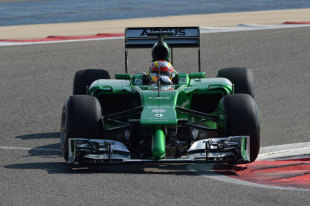- Interview with Robin Frijns
'I don't have a problem with what other people say'
Kate Walker February 25, 2014In an exclusive interview with ESPN, Caterham reserve driver Robin Frijns talks about the pressure of being a hot young talent without a drive

Every once in a while, a driver arrives in the paddock with a certain weight of expectation surrounding their debut. It happened with Lewis Hamilton in 2007, and it's happening again at McLaren this year with the arrival of Kevin Magnussen. But slightly further down the pitlane is another new signing whose reputation has preceded him.
Caterham reserve Robin Frijns has been in the F1 paddock before, of course. He tested for Sauber and Red Bull during the 2012 Young Driver Test in Abu Dhabi, and was signed as Sauber's test driver for the 2013 season. But the role didn't see Frijns take part in any Friday morning sessions with the Swiss team, denying him the opportunity to show off his skills to F1's sizeable fanbase.
Having previously dominated championship after championship - Frijns estimates he's won around 300 trophies since he first started karting as a child - the Dutch racer has long been linked with a persistently elusive race drive. Now that he has the chance to audition on Friday mornings, does he feel the pressure?
On Thursday morning in Bahrain Frijns sat down with ESPN to talk about his work with Caterham, his hopes for a race seat, and what it's like to know that the weight of expectation lies on your shoulders.
"I don't see it as pressure, really," he said. "I see it as a good thing that everybody trusts in me - it gives me a good feeling. But I don't see it as pressure to perform in the car - I always do the best I can do anyway. I want to do the best for the team, help the team move forward.
"I don't have a problem with seeing what other people have said and written about me as pressure to perform. I know what I can do, and I know what I can't do, and when I'm sitting in the car I just do the best job I can and see where we end up. "
The first day of the Bahrain test saw Frijns as Renault's most valuable property. With 68 laps under his belt, he was Viry-Chatillon's most productive driver by far, providing them with reams more data than any of their other customers. But the 22-year-old refused to take any credit for the achievement.
"The team did a very good job in the days between Jerez [and the first Bahrain test]," he said. "We had some problems here and there, which is quite normal. Everybody did - some more than the others. The team is working 24 hours straight to ensure we can do as many laps as we can do."
In the current era of limited time spent track testing, simulator work has - by necessity - become a key part of an F1 reserve's workload. But according to Frijns, one of the less publicised effects of the 2014 regulation change has been its effect on the team's simulators.

"The simulator is different now, because the car is completely different to last year," he said. "We have a lot less downforce, and kind of the same power, but the power comes differently. So we have to work on that, deliver that in the simulator to make sure we get the same feeling as in the car. Which isn't easy. And it's why you have to drive the car to be able to say what is needed in the simulator.
"I didn't go in the simulator before [the first] Bahrain [test] because I didn't drive in Jerez. Well, I did 10 laps, but that's about 50km, so I couldn't say anything about the car. But I did some laps of the Bahrain circuit in the simulator before Jerez."
While the power and loss of downforce need to be replicated in the simulator, so too does the break-by-wire system [BBW] that has proved to be quite challenging for a number of drivers to adjust to. And until the car-based feedback can be incorporated into the sim to ensure both devices are behaving in the same manner, it's hard to establish the correlation between reality and simulation.
"It's different. That's why it's so hard to compare, because you don't know if the simulator is working with the BBW, or if you put it on the car and it's completely rubbish. We have to make it as similar as we can get between the simulator and the real car, which is really hard to do."
But, like the pressure, Frijns' response is to rise to the challenge, always with his endgame in sight. "Of course my goal is to get a race seat as soon as possible. That's my goal. But when I have a chance in the car in FP1 or in a test I will try and help the team, try and give as much feedback as I can give, try and make everybody happy, to earn their trust in me as a member of the team. The whole story is just to do your best when you're in the car, and hopefully it's enough."
It's the same pragmatic yet ambitious approach the young Dutch racer takes when discussing his team's likely prospects. "To be honest, if I was racing this year in the Caterham car, it would be very difficult to get on the podium," he admitted. "Points are a victory for us, and that's our goal for this year. We are trying to develop a reliable car, which is one of the keys of this season, if everyone has problems. As long as we try to finish races, the points will come. That's our goal. We have to see how it goes, because everything can change."

